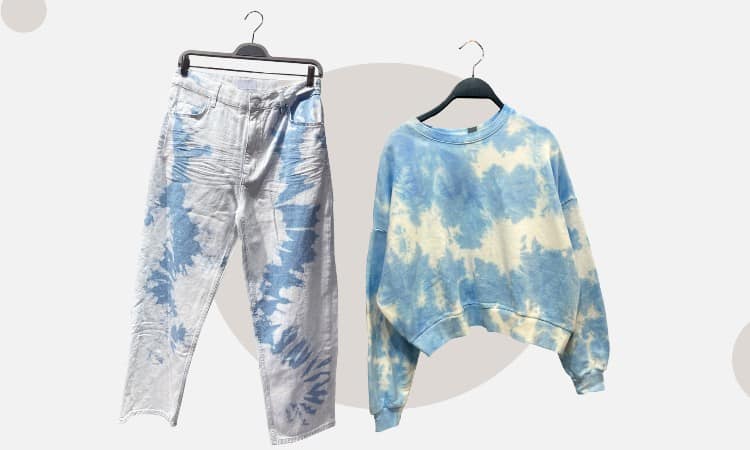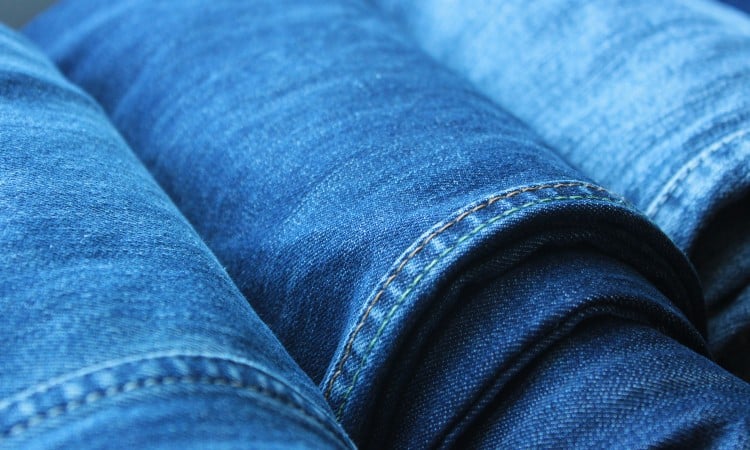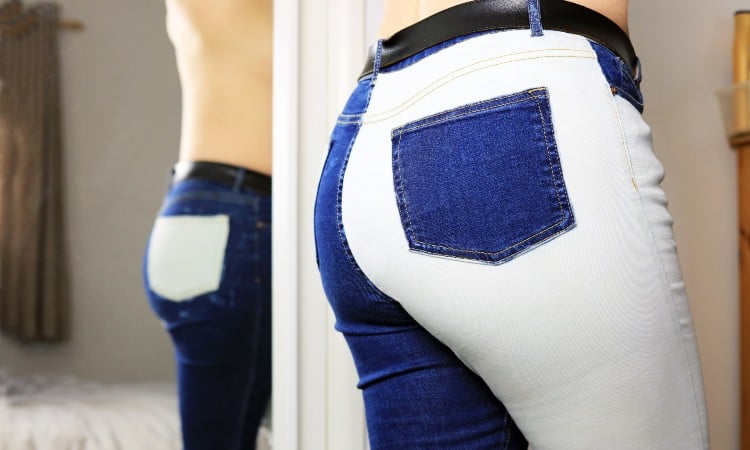I’ve found a great way to refresh my well-worn jeans. Tie dying them! Who doesn’t like rainbow-colored jeans, right? But is it possible to tie dye denim? It’s such a heavy fabric. Before I get started, I need to find out how to tie dye jeans.
Jeans are easy to tie dye. Twist or fold the jeans and hold them in place with elastic bands. The dye will only cover the exposed areas, leaving the folded sections untouched. This technique works best on 100% cotton denim and light-colored jeans. Any polyester content will hinder the process as it won’t absorb the dye.
In this article, we’ll take a look at how to tie dye jeans. We’ll also cover why 100% cotton or light-colored jeans are easier to work with.

Can You Tie Dye Jeans?
Yes, you can tie dye jeans. Although, the results you get will vary depending on the fabric content and color of the jeans you are trying to dye.
Denim is an extremely hardwearing and durable fabric. Not only is it strong when it’s dry, but you can also be as rough as you like with it when it’s wet. This feature comes in useful when you want to tie dye your jeans.
The art of tie-dyeing fabric involves twisting and twirling the material into tightly scrunched up shapes. It’s a bit like how you would wring water out of a garment when it’s wet. When you’re tie-dyeing, keep the textile in the tight coils with elastic bands or ties.
Denim is probably one of the best fabrics for this particular dyeing technique due to its robust and sturdy construction. You’re not restricted to jeans either. Tie-dyeing any denim garment from shirts, jackets, and cut-off shorts will give your wardrobe a fresh pop of color. Your very own piece of wearable modern art.
However, not all denim fabrics are created equal and you do have to pay attention to the fiber content in the jeans you are hoping to tie-dye. Make sure you read the care label on your jeans to make sure they are 100% cotton before you attempt to dye them.
100% cotton is super absorbent. It will act like a sponge and suck up all the dye. This is great news when it comes to tie-dyeing jeans. You’ll get a vibrant, all-over pattern with symmetrical coverage. All of that goes down the tubes if your jeans have any synthetic content. Any hint of polyester or stretch in your denim will throw your design for a loop.
Polyester, in particular, doesn’t take to dye. It is incredibly difficult to change the color of polyester fabrics once they have been made. This is why color is added to this material during the production process. To change the color post-production, you need special dyes and more than a little bit of luck.
A polycotton blend of the denim will result in a blotchy tie-dye effect rather than even coverage. You may find some areas of your jeans are less vibrant. They may not change color at all. Now, it has to be said the whole point of tie-dyeing is the spotted results. But, and it’s a big cautionary but. Rather than a unique piece of fashionable, abstract art, you could end up with unsightly streaks.
It’s not just fabric, either. Even if they are made with 100% cotton denim, some jeans are stitched using polyester thread. What this means, when you come to tie dye your denim, the stitches will stay the original color.
Unfortunately, many manufacturers don’t mention if they use polyester thread on the label. However, it may be worth testing a small part of the stitching before committing to any dyeing project.
There’s one more factor you need to consider when deciding if you can tie dye your jeans. What color are they now? Darker shades of jeans will be harder to tie dye. Simply because it’s always difficult putting color over the top of dark pigments. You may have to bleach your jeans to remove the color before you tie dye them.
For the best results, start with a white or light-colored pair of jeans. Lighter jeans are more of a blank canvas and you’ll find they will pick up the color easier, particularly if they are made from 100% cotton.
How to Tie Dye Jeans

When it comes to tie-dyeing your jeans, you have a choice of two options. The one you choose depends on the color you start with. For light-colored or white jeans, the first of the following methods will work. If you have dark blue or even black jeans, you might need to choose the second.
The next thing you’ll need to consider is the colors you want to use. You can use any color you like when you’re tie-dyeing jeans. If you use multiple shades for a rainbow effect, watch out for color bleed. Colors next to each other are likely to run and overlap.
This will help create a natural switch from one vibrant shade to another as long as you choose your pigments wisely. Some colors mixed are going to create dingy brown or black spots. For a rainbow effect of pastel hues, you need to refer to the color wheel.
A color wheel will show primary colors like red, yellow, and blue sitting opposite the colors and shades that contrast. So for red, the contrasting color would be green. For blue, it would be orange. You need to avoid putting patches of blue dye next to orange because you’ll lose vibrancy and end up with a subdued brown. Red and green will also go brown.
To keep your jeans colorful, you need to stick to non-contrasting colors. Mix red and yellow to get orange. Or even red and blue for a nice hint of purple. Varying the amounts of each primary color will create deeper or lighter hues.
Now the science is out of the way, let’s get into tie-dyeing. Read through these step-by-step instructions for tie-dyeing jeans before you start your project. That way, you can pick the best one for you and your denim.
Method 1 – Adding Color
You will need:
- Your preferred dye
- Washing machine
- Plastic sealable bag
Dyes contain chemicals, so you need to treat them carefully. Whenever you are using commercial dyes or tie-dye kits, make sure you follow the instructions on the box for optimum results.
Step 1
Check the fiber content of your jeans to make sure they are 100% cotton and make sure they are white or a light color. Wash your jeans to make sure they are completely clean. Wring them out to remove any excess water but don’t allow them to dry.
Step 2
While your jeans are still wet, scrunch them, twist them, or fold them into the shape of your choice. Apply the dye to the sections you want to change. If you are using several colors, apply them to different areas. To avoid the different hues mixing, make sure you leave blank areas between each shade. Turn the jeans over and over to make sure you get total coverage where you need it and ensure the dye soaks into the fabric.
Step 3
Carefully place the jeans into a sealed plastic bag and allow them to sit for a while. Refer to the dye manufacturer’s instructions to find out how much time you should leave them for.
Step 4
When the time has elapsed, remove the jeans from the bag and rinse them out. Finally, wash and dry your jeans as instructed on the packaging.
Method 2 – Bleaching Out the Original Color

For darker shades of blue or black, you’ll need to remove the original color of your jeans before attempting to tie dye them. You can use bleach to remove all the color or remove it from specific areas.
You will need:
- Bleach
- Rubber gloves
- Hydrogen Peroxide
- A well-ventilated area
- Water
- Spray Bottle
- Basin, sink, or bucket
Step 1
Wash your jeans to make sure they are completely clean. Any dirt will hinder the bleaching process and leave patchy marks. Don’t dry them once the wash cycle has finished.
Step 2
If you only want to bleach some areas, twist, twirl, or fold your jeans, so only the parts you want to treat are visible. You’ll want to do this while your jeans are still wet. If you want to remove the color completely, leave your jeans untwisted.
Step 3
Make up a mix of bleach and water. The best ratio for this is a 50/50 split. You need enough mixture in your sink, bucket, or basin to cover your jeans. Submerge your jeans in the solution and leave for 15-20 minutes. It’s best to wear gloves for this part and make sure you are in a well-ventilated room. Better still, do this outside.
If you want to bleach small areas, or have a more spotted effect, apply the bleach using a spray bottle.
Step 4
Wearing your rubber gloves, rinse out the jeans under cold running water. Once you are happy you have removed as much of the bleach as possible, wash your jeans in the washing machine. You can use your normal wash setting for this. Don’t add any other garments to the wash, though, as the bleach will remove the color from them too!
Step 5
Pour hydrogen peroxide over your jeans at the end of the wash cycle. This will remove any residual bleach left over in the fabric fibers. Rewash the jeans and dry them as you would normally.
Can You Tie Dye Chambray Jeans?
Chambray is a similar fabric to denim and can be tie dyed just as easily. The weave is slightly different, which gives the chambray a lighter, more flexible feel. In many ways, chambray is like denim’s little sister.
With many of the same qualities as denim, your chambray jeans, shirt, or even dress will react to dye in the same way. You’ll get incredibly similar results. As it’s hardwearing and durable, it can also withstand the twirls, twists, and folds you’ll have to put it through for the tie dye technique.
Be aware that, just like denim, chambray fabric made from 100% cotton will work better than a synthetic blend. So too will a lighter color.
Can You Tie Dye Black Jeans?
Yes, you can tie dye black jeans. However, you may find saying you can is a lot easier than actually doing it. Dyeing any garment that starts with black as its original color will be tricky. Jeans are no exception to this. In fact, they may be harder to dye.
The reason for that, denim is incredibly thirsty when it comes to dye. The fabric, especially 100% cotton, will soak dye up like a sponge, which is great if you’re dyeing your yellow jeans black. Not so great if you’re going from black to yellow.
It’s not as simple as dyeing over the top of a dark color. That original dark shade is already embedded deep into the denim fibers and shines straight through the yellow. It’s not going to look good.
Unfortunately, dark blue, brown, and black are notoriously difficult to cover with a lighter color. This is why you have to remove the original color first.
To do that, you’ll need to bleach your jeans. Your first decision is to choose between removing all the color or just taking it from selected areas. Follow our step-by-step guide for Method 2: Bleaching Out the Original Color in the section above.
While your newly bleached black jeans are still wet, start adding dye to different sections. Now that the black pigment has been removed from some areas, you’ll find it’s a lot easier to tie dye your denim jeans.
There is a word of caution, black jeans containing polyester or sewn with polyester thread will be less likely to take to the dye. Polyester isn’t fond of bleach either, so make sure you check your garment’s fiber content before starting.
How to Tie Dye White Jeans
Tie-dyeing white jeans is a super easy process. As white is a light color, there’s no need to worry about bleaching out any original pigment. It’s simply a case of washing your jeans and adding the tie dye colors.
As with other shades of jeans, you do have to watch the fiber content. The best denim for dyeing, especially tie-dyeing, is 100% cotton. Not only will the cotton take to the dye like a duck to water, but the overall effect will be more evenly spaced and natural-looking.
For best results, follow our step-by-step guide for Method 1: Adding Color, in the section above. This option is ideal for white and light-colored denim jeans.
Conclusion
Denim jeans and the technique of tie-dyeing go hand in hand. Denim is probably one of the easiest fabrics to dye using this method. They work so well together too!
Jeans are the go-to accessory for casual fashion. But add a tie-dye effect, and your denim pants are now super chic and oozing individual style. You’ll be the envy of all your friends.